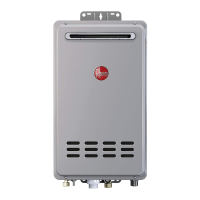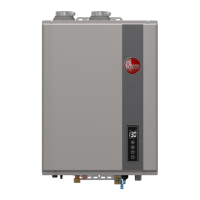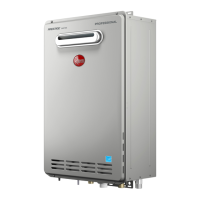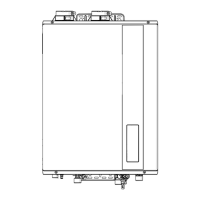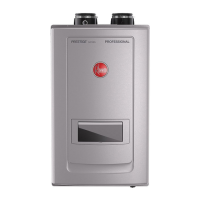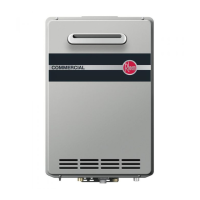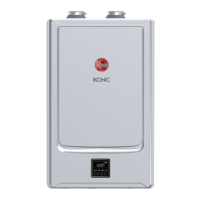38
Plumbing
INSTALLATION INSTRUCTIONS
Water Supply Connections
CAUTION:
IMPORTANT—DO NOT apply heat to the HOT or COLD water
connections. If sweat connections are used, sweat tubing
to the adapter before fitting the adapter to the water
connections on the water heater. Any heat applied to the
water supply fittings will permanently damage the internal
components of the water heater.
NOTICE:
In cold environments, ice can accumulate in the water
heater’s connectors. Plug in the water heater power
cord for approximately 10 minutes before making these
connections. This will melt any ice buildup.
Plumbing should be carried out by a qualified
plumbing contractor in accordance with local codes.
Only use approved plumbing materials.
To allow the full flow capacity, it is recommended
to keep water inlet and outlet pipes 3/4" (1.9 cm)
diameter or larger.
To conserve energy and to prevent freezing, insulate
both COLD and HOT water supply lines. DO NOT
insulate the drain line or pressure-relief valve.
Recirculation
Direct recirculation is allowed, provided the loop is
thermostatically controlled, and a timer is used to
turn the pump off during off peak periods. The pump
must be sized for a minimum of 5 gpm at 25 ft of
head plus building head. A 10°F difference between
the loop thermostat setting and water heater
temperature setting must be maintained.
To ensure proper operation of the water heater,
follow these water pressure guidelines.
Operation of the water heater requires a minimum
water pressure of 14 psi (97 kPa) and a minimum
water flow rate of 0.4 gpm (1.5 lpm).
Water pressure of 40 psi (276 kPa) is required to
achieve maximum flow rate.
To maintain proper performance, there must be
sufficient water supply pressure.Required Water
Pressure =
Min. Operating Water Pressure (14 psi [97 kPa])
+ Pipe Pressure Loss
+ Faucet Pressure Loss
+ Safety Margin (more than 5 psi [34 kPa]).
To supply HOT water to upper floors, additional
water pressure will be required (0.44 psi [3 kPa]
per foot of height). Calculate the distance between
the water inlet of the water heater (ground level) to
the HOT water faucet farthest away from the water
heater (upper floor level).
Well water systems should be set to ensure a
minimum system pressure of 40 psi (276 kPa). The
pressure should remain constant and stable during
the operation of the water heater.
Gravity water pressure is not recommended. When
the water is supplied from a water supply tank, the
height of the tank, the diameter of the supply pipes,
and their relation to water pressure need to be taken
into consideration.
Thermal Expansion
Determine if a check valve exists in the inlet water
line. Check with your local water utility company.
It may have been installed in the cold water line as
a separate back flow preventer, or it may be part
of a pressure reducing valve, water meter or water
softener. A check valve located in the cold water inlet
line can cause what is referred to as a “closed” water
system. A cold water inlet line with no check valve
or back flow prevention device is referred to as an
“open” water system. As water is heated, it expands
in volume and creates an increase in the pressure
within the water system. This action is referred to
as “thermal expansion”. In an “open” water system,
expanding water and the resulting pressure increase
which exceeds the capacity of the water heater,
flows back into the city main where the pressure is
easily dissipated.
A “closed” water system, however, prevents the
expanding water from flowing back into the main
supply line, and the result of “thermal expansion” can
create a rapid and dangerous pressure increase
in the water heater and system piping. This rapid
pressure increase can quickly reach the safety
setting of the relief valve, causing it to operate
during each heating cycle. Thermal expansion, and
the resulting rapid and repeated expansion and
contraction of components in the water heater and
piping system can cause premature failure of the
relief valve, and possibility the heater itself.
NOTICE:
Replacing the relief valve will not correct the problem!
The suggested method of controlling thermal
expansion is to install an expansion tank in the cold
water line between the water heater and the check
valve.
The expansion tank is designed with a built-in air
cushion that compresses as the system pressure
increases. This relieves the over-pressure condition
and eliminates the repeat operation of the relief
valve. For other approved methods of thermal
expansion, contact an installing contractor, water
supplier, or plumbing inspector.

